The huge dome in Lisbon, the one that can be seen all over Alfama as well as from the other side of the river, is Santa Engrácia – The National Pantheon of Portugal. Here you will find tombs of Portuguese presidents, explorers, artists, and other heroes, as well as a magnificent view from the rooftop terrace.

What will you see at Santa Engrácia – The National Pantheon?
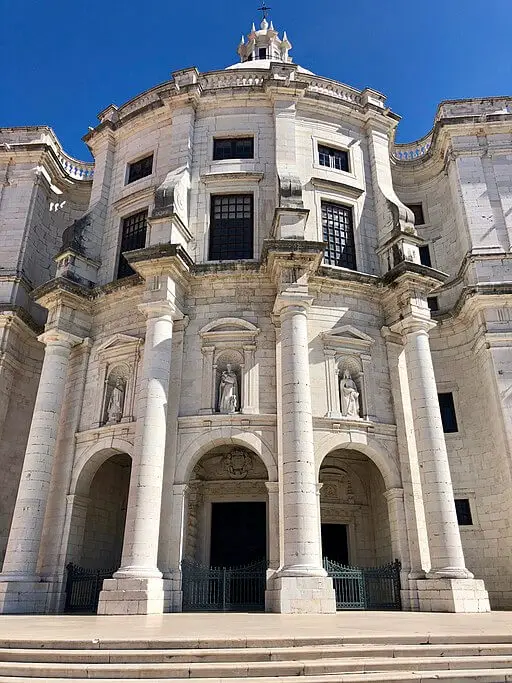
The main entrance is a masterpiece of Baroque sculpture by French sculptor Claude Laprade.
Two angels hold Portugal’s coat of arms.
The interior was inspired by St. Peter’s Basilica in Rome and is covered by polished multicolored marble.
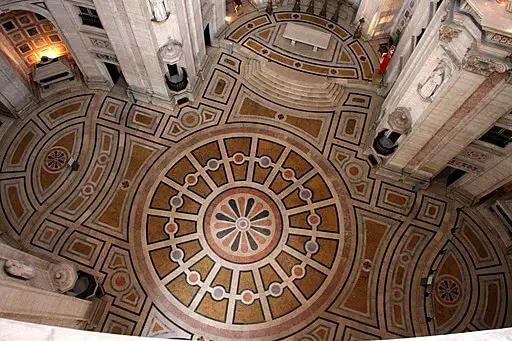
The church has an octagonal floor plan, centered on a Greek Cross.
Each wing of the cross is equal in length.
The symmetrical design can be viewed from the balcony high above.
There is no elevator to the upper gallery or the roof. There are six flights of stairs.
There is no statuary in this church, and the central feature, behind a simple altar, is the18th century organ that came from the Lisbon Cathedral. Lisbon Cathedral | All you need to know before you go
The highlight of a visit is going to the rooftop and taking in the views.
The best time to visit is on a Tuesday or Saturday morning so that you can also check out the Feira da Ladra flea market next door.
Who is buried in the National Pantheon?
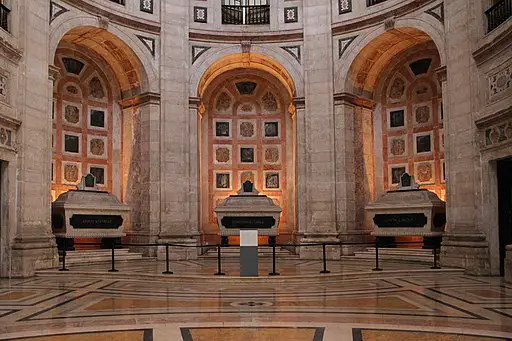
- President Manuel de Arriaga – The first attorney general and the first elected president of the First Portuguese Republic, following King Manuel II stepping down from the throne and fleeing the country. He was in office from 1911 – 1915. There was a Provisional Government led by Teófilo Braga prior to his taking office.
- President Teófilo Braga – A writer and playwright, he led the Provisional Government that transitioned between the throne and democracy, and then was the second president of Portugal, for six months in 1915 when Manuel de Arriaga resigned.
- President Sidónio Pais – The fourth president of Portugal, he served on the committee that wrote the constitution, but then seized the presidency through a coup. He later gave the people the right to an election in which they voted him into office. A supporter of the church, he was wildly popular with the rural Catholics who made up the majority of the population. He was assassinated in the Rossio train station in 1918.
- President Óscar Carmona – The 11th president of Portugal from 1926 until 1951. He appointed António de Oliveira Salazar to become Prime Minister. In 1933 a new constitution established the Estado Novo, and Salazar ran Portugal until 1968. Although Salazar insisted on the completion of the National Pantheon, he is not buried here. He asked to be buried in his hometown.
- Presidential Candidate Humberto Delgado – The youngest general in the history of Portugal, he founded the airline Transporte Aéreos Portugueses. He ran for president in 1958.
- Writer João de Deus – Lived from 1830 – 1896. Educator and popular poet.
- Writer Almeida Garrett – Lived from 1789 – 1854. A poet, orator, playwright, politician, he suggested the creation of the D. Maria National Theater and the Conservatory of Dramatic Art.
- Writer Guerra Junqueiro He lived from 1850 – 1933. He was a poet who criticized the church and his anti-monarchy writing helped inspire the First Portuguese Republic.
- Writer Aquilino Ribeiro One of the great 20th-century Portuguese novelists, he was nominated for the Nobel Prize for Literature in 1960.
- Writer Sophia de Mello Breyner Andreson – Lived from 1919 – 2004. An award-winning poet and children’s book author, she also translated Dante and Shakespeare into Portuguese.
- Fado singer Amália Rodrigues – Lisbon’s legendary fado singer lived from 1920 – 1999.
- Football star Eusébio – Considered one of the greatest football players of all time. Playing for Benfica he had 733 goals in 745 games. With the Portuguese national team, he had 41 goals in 64 games. He led Portugal to third place in the 1966 World Cup.
There are cenotaphs, empty graves, or monuments to the following heroes who are buried elsewhere:
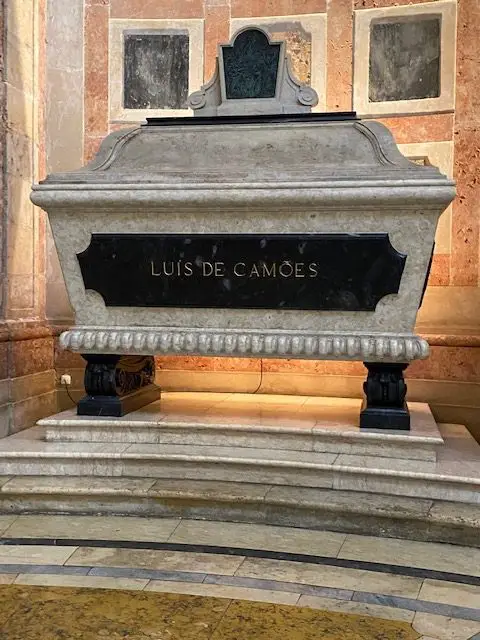
- Warrior Poet Luís de Camões He lived from 1525 – 1580. The National Poet of Portugal, he was also a knight who lost his eye while fighting against the Moors in Ceuta, northern Africa. Sometimes he is compared to Shakespeare, Virgil, Homer, and Dante. His epic work is Os Lusiadas. He is said to be buried at the Jerónimos Monastery.
- Pedro Álvares Cabral The explorer discovered the northeast coast of Brazil in 1500. He claimed his discovery for Portugal. Cabral was the first explorer to lead an expedition that touched four continents (Europe, Africa, America, Asia) in 1497. He is buried in the city of Santaréém, northeast of Lisbon.
- Afonso de Albuquerque The military commander fought Islam, spread Christianity, and built the Portuguese spice empire. He was Viceroy of Portuguese India from 1509 – 1515. He is buried at Nossa Senhora da Graça Church in Lisbon.
- Nuno Álvarez Pereira A general who led the fighting and won independence from Castile in 1385, he later became a monk and founded and lived in the Convento do Carmo. See my article Lisbon’s Convento do Carmo Ruins | Everything You Need to Know He was sainted in 2009 by Pope Benedict, and is known as Santo Condestável – The Constable Saint. His grave was lost in the 1755 earthquake.
- Vasco da Gama Born around 1460. He lived until 1524. He was the first European to reach India by sea in 1498, and his journey established Portugal as the dominant player in the spice trade, making Portugal one of the wealthiest countries in the world at the end of the 15th century. He is buried in the Jerónimos Monastery.
- Henry the Navigator O Infante Henrique was a prince who lived from 1394 – 1460. He funded and directed the Portuguese Age of Discovery, creating Portugal’s overseas empire. Under Henry, craftsmen designed new ships, maps, and tools for seagoing. Although he never actually led an exploration, he was knighted for his leadership in taking Ceuta (present-day Morocco), and under his leadership Portugal claimed Madeira and the Azores. He is buried in the town of Batalha.
- Aristides de Sousa Mendes A Portuguese consul stationed in Bordeaux, France during WWII, he defied orders and personally granted visas to thousands of Jews who were allowed to pass through Spain, enter Portugal, and then pass out of Europe to safety.
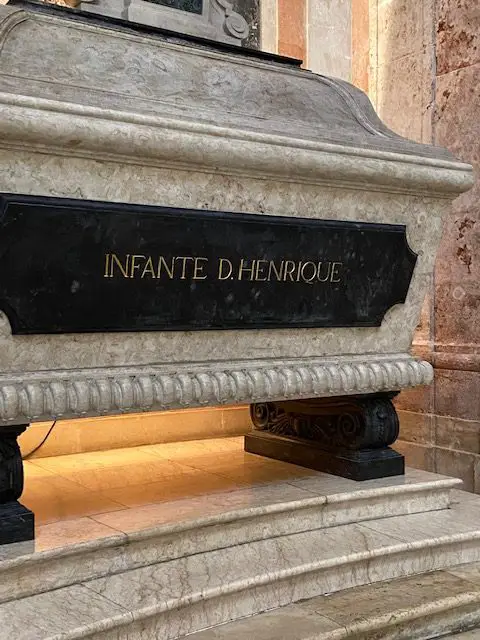
History of Santa Engrácia Church and the National Pantheon
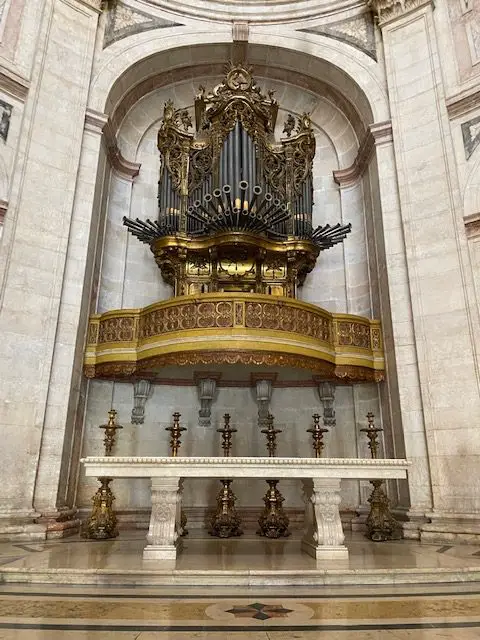
The Church of Santa Engrácia (Igreja de Santa Engrácia) stands on the site of several earlier churches.
Construction on the current building began in 1681 under the direction of architect João Antunes. When he passed away, work on the project stopped for nearly 200 years.
The building was not completed until the final addition of the dome in 1966.
As a result of this never-ending construction project, Portuguese people refer to a project that won’t end as an “Obra de Santa Engrácia” (A work of St. Engracia).
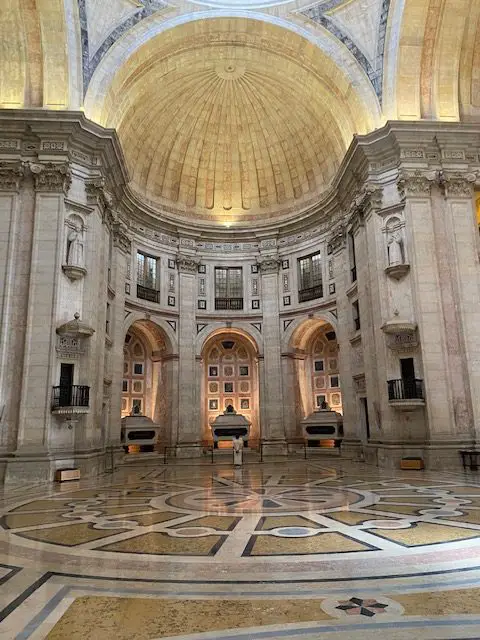
Legend has it that the construction took forever because of karmic reasons.
One of the earlier churches on the site was robbed in 1630.
A converted Jew, Simão Peres, was blamed and put to death for it.
As it turns out, he was innocent. He had apparently been visiting his girlfriend, Violante – a nun in the nearby Santa Clara Convent during the robbery, but chose not to say anything in order to protect her.
Before he was executed, he said that the church would never be completed because an innocent man was being murdered.
The 1760 m2 Baroque church was never used as a place of worship.
In 1916 during the Portuguese First Republic, the church became the National Pantheon, where some of Portugal’s most famous citizens are buried.
Visiting Hours
From October to March, Open Tuesday to Sunday from 10 am until 5 pm (last entry 4:40) Closed Mondays.
From April to September, Open Tuesday to Sunday from 10 am until 6 pm (last entry 5:40) Closed Mondays.
Also closed on January 1, Easter Sunday, May 1, June 13, December 24, and 25.
Signage is in English and Portuguese. The National Pantheon has access for visitors with reduced mobility (although not the upper gallery or the rooftop viewing deck).
Official website: DGPC | National Pantheon (patrimoniocultural.gov.pt)
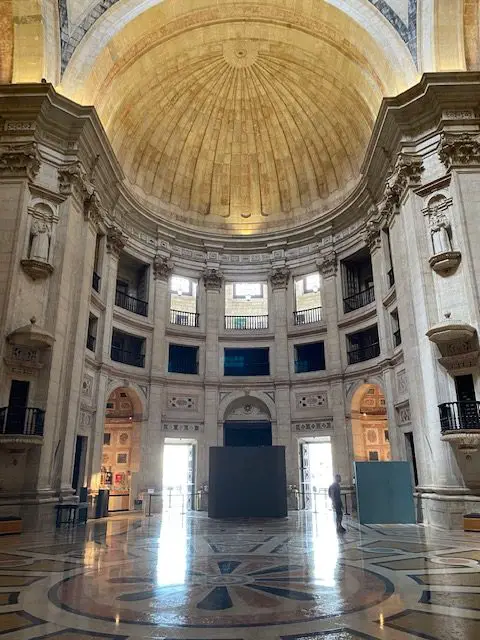
Admission
€4.00 General Admission. Seniors pay €2.00 You can also buy a combination ticket for the National Pantheon and the National Tile Museum National Tile Museum in Lisbon | A Quick Guide for €7.00
How to get to the National Pantheon
Campo de Santa Clara
GPS Coordinates: 38.71505716473083, -9.12496245203054
Take Tram 28 to the Voz do Operário stop. For more information on Tram 28, read my Get off in front of the São Vicente de Fora Monastery. Go down the street beside the monastery and pass the arch – Arco Grande de Cima, You will be in Campo de Santa Clara, and you will see the National Pantheon from there.
Bus 712, 728, 734, 735, 704, 745, 759, 781, 782
Closest metro station: Santa Apolónia (blue line). You will have to walk uphill for roughly ten minutes.
Some free parking is available in front of the National Pantheon.
What’s Near the National Pantheon?
- Feira da Ladra (Thieves Market) at Campo de Santa Clara is a seventy-year-old flea market held behind Santa Engracia every Tuesday and Saturday. For more information, see my, Feira da Ladra – Lisbon’s 750-year-old flea market
- The Fado Museum To learn more about Fado, read my article Everything you need to know about fado music in Lisbon
- Mosteiro de São Vicente de Fora – Burial site of most of the Bragança kings. It also has the largest collection of Baroque azulejo in the world, and affords a spectacular view of Lisbon from the rooftop terrace. For more information, read my Visit São Vicente de Fora in Lisbon: Everything you need to know
- Miradouro da Graça scenic viewpoint
- Miradouro da Santa Luzia scenic viewpoint
- Tram 28E To learn more, see my Where does Tram 28 stop? All you need to know about Tram 28
Thank you for reading about Santa Engrácia and the National Pantheon. If you are looking for a unique place to stay while you are in Lisbon, see my article, (Updated) Lisbon’s most interesting hotels (truly unique lodging in Lisbon)
I am not associated with any of the businesses mentioned in this article.